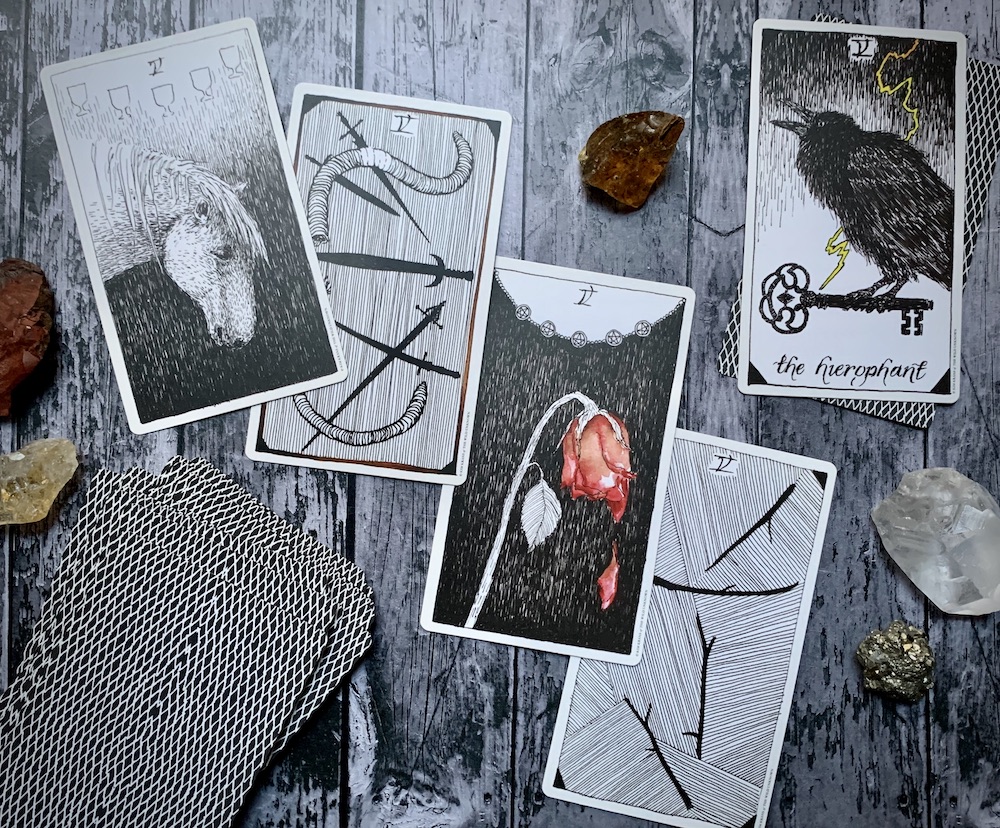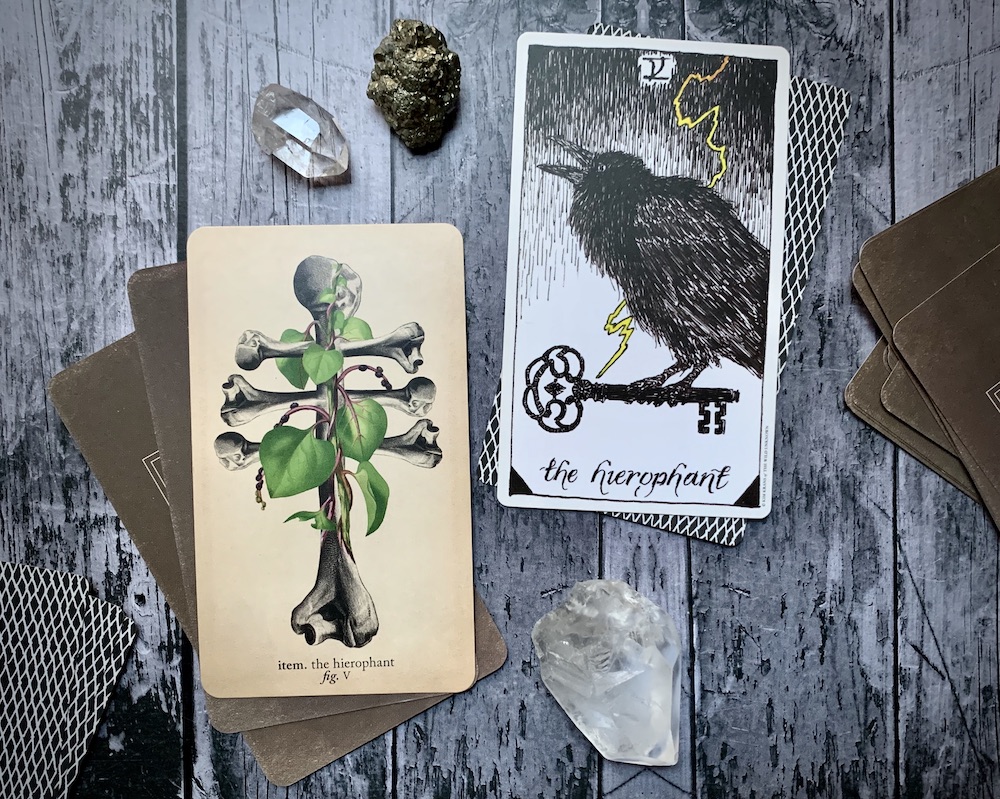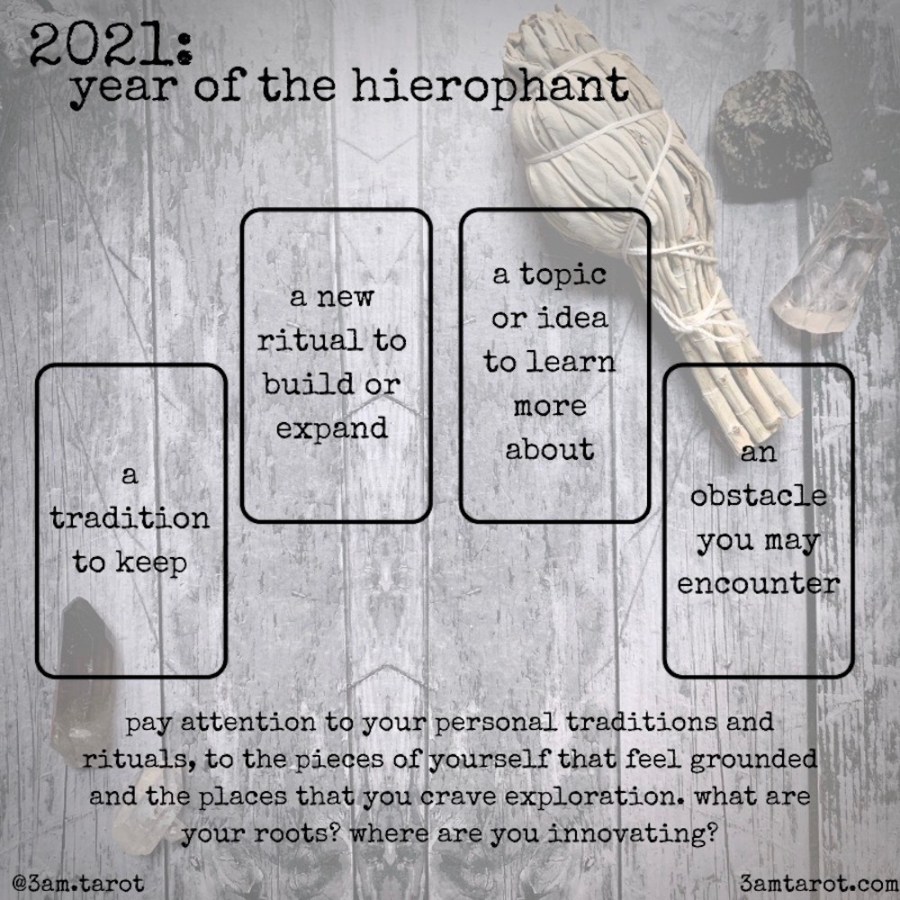Last year was one of the Emperor numerologically, though it felt more like a Hanged One year emotionally — structures butting up against sacrifice, a necessary mingling of control and surrender. And while this year will likely carry a bit of that Hanged One energy forward, our numbers for this new year offer opportunities to change our thinking. As you reflect on the discipline that you found in 2020, the rules and objectives that you created and clarified, the foundations that you established towards broader goals, I hope that you’re also able to think about your past, present, and future through a new lens. What are you leaving behind, and what are you carrying forward? What have you built and solidified, and what you have abandoned? Where did you invest time and energy, and how did that serve you?
Following the same simple exercise that we used last year, by adding the digits of 2021 together (2 + 0 + 2 + 1) we get a total of 5, our number for this new year. Fives in tarot connect to the Hierophant, an archetype that is often seen as a priest, religious leader, or keeper of knowledge. Austere and set apart, authoritative and powerful, Hierophants are usually associated with traditions, rituals, history, information, and education, figures that by their very nature are tethered to the past. In the fool’s journey through the major arcana, the Hierophant encourages us to begin looking to others for spiritual guidance, inspiration, and teachings, as well as to consider the ways that we let those with more experience or knowledge guide our actions. Which beliefs feel personal and internal, and which feel like they exist outside of us? After the intensive restructuring demanded of us in 2020 from the Emperor, 2021 calls us to consider where we have found comfort in shared heritage and connective rituals, and where we have allowed ourselves to be restricted or held back by placing too much value on tradition. What rules are we ready to break?
If, like last year, this particular archetype feels deeply tied to the kind of heteronormative patriarchal structures that so often harm, it may feel difficult to fully embrace this energy. For many queer folks, especially those of us with religious trauma or conservative upbringings, the Hierophant can bring up a lot of pain, sorrow, guilt, and anger. Yet there are so many ways we can interpret this archetype, methods we can use to redefine and reclaim what this figure means for us. Some see the Hierophant as a singular mentor or teacher, spiritual or otherwise, while others see them as a representative of a broader learning community, a group of students that are committed to studying and growing together. Still others view the Hierophant as someone that encourages us to establish rituals of our own, personal traditions and sacred practices that connect us to ourselves or to others. Instead of seeing this card as one that pushes us to rigidly cling to the old ways, consider what traditions in your spiritual, physical, or emotional life offer you a sense of grounding, stability, and comfort.
What are we ready to learn? How has our collective past helped us find grounding and community, and how have we been clinging to rituals that are inherited instead of intentional? How do you understand your own roots? What parts of your personal history feel healing and secure, offer you a sensation of peace and shelter, give you hope and comfort? Rituals can be as simple as a quick morning affirmation or as complex as an elaborate Passover seder, but what’s important is how these practices anchor you, connecting you to both past and future.

Looking beyond the Hierophant, fives in the minor arcana also have much to teach us. These cards deal with tension, friction, necessary conflict or grief. The five of wands demonstrates what happens when we try to light multiple fires at once, losing our larger direction and feeling a deep, frustrating restlessness. The five of swords is a charging forward, a determination to win at any cost, a willingness to do harm simply so we can feel a brief, fleeting sense of triumph. The five of cups explores loss and sorrow, a focus on what we no longer have that separates us from the good things that still remain. And the five of pentacles holds space for a lack of resources, a grief over what we are without paired with an unwillingness to accept the help that has been offered. These cards all sit between worlds, vibrating and straining, feeling constrained by what has come before yet uncertain of how to move forward. Yet they also speak of breakthroughs, of the moments that we see things clearly or feel things deeply, that we recognize how necessary a change or leveling up is for us to continue making progress. What is cracking, shifting, revealing itself? What is being exposed, both within us and around us?
The Hierophant can be an anchor to the past, yes — but when we give the past all of the power, when we find ourselves so attached to how things have always been that we cannot see the ways that they could be, we can get trapped in tradition, held back by a sense of rigid obligation. After spending 2020 evaluating structures and creating new rules, 2021 will challenge us to keep pushing ourselves to grow and expand, to consider what we are allowing to restrict us and why. Evolution is not easy, transformation is not simple, and giving ourselves the freedom to play and grow, to leave old things behind, is easier said than done. We speak so often of leaving behind that which no longer serves us, of new beginnings, yet the actual process of doing so is messy, can be painful or confusing. Fives in major and minor arcana live in this tense, in-between space, acknowledging the ways we stretch and push, the struggle to create new spaces that we can inhabit.

Where are you ready to break free of old tethers? How have you been holding yourself back? If the Hierophant feels like more of a gatekeeper than an invitation, consider why that is. Where have you restricted yourself? Where have you established rituals of limitation? What have you not allowed yourself to explore, and where does that tendency come from? What voices from the past are you still allowing to dictate your present, or even to influence your future? This archetype can be a skeleton, a foundation, a place that we find comfort and anchors and stability — but it can also be a key, a doorway, an opportunity for rich growth and powerful exploration. What are you seeking this year? And how can tapping into the dualistic nature of the Hierophant help you make a plan to find it?
As you find your footing in 2021, as you consider all that you are leaving behind and all that you are stepping into, this new spread can help you look at these connective threads through a new lens. Look at this new year as one of opportunities for both expansion and contraction, for doubling down on the rituals that serve you and releasing old traditions, thought patterns, or practices that have been limiting your growth.

A tradition to keep: Something already established that is solid, worth holding on to. What makes you feel grounded, strong, protected? Where have you created containers that support your work, your loves, your dreams?
A new ritual to build or expand: Something to introduce into your personal cycles, a practice or habit or question to explore. What have you felt drawn to? What’s something you can add to your world that could encourage or stimulate new growth?
A topic or idea to learn more about: Something to explore, a place to indulge your curiosity or desire. Where can you expand your knowledge? What have you always wanted to learn or understand? Where can you challenge yourself?
An obstacle you may encounter: Something that may create a sense of conflict, frustration, grief, or loss. What might push you to reflect or evolve? What is your relationship to friction or discomfort? How do you navigate challenges?
As you reflect on your past, enjoy your present, and set intentions for your future, pay attention to the personal and collective traditions that you are upholding. What value do they offer? Where might you build something new, something unique, that gives you new opportunities for expansion and exploration? Where is your own sense of rigidity or stubbornness limiting your options, and how can you open yourself to possibility? Where are you ready to innovate, and what is worth preserving?

Thank you for this.
🖤🖤🖤
this is great! thank you
thank you! 🖤
Thank you for this! Could you share what deck the first card (with the skeleton figures) is from?
yes, the skeleton-style deck is called the antique anatomy tarot, and the animal deck is the wild unknown tarot 🖤
Thank you so much!
Beautiful writing! Thank you for this.
thank you so much! 🖤
What’s something you can add to your world that could encourage or stimulate new growth? Slope 2